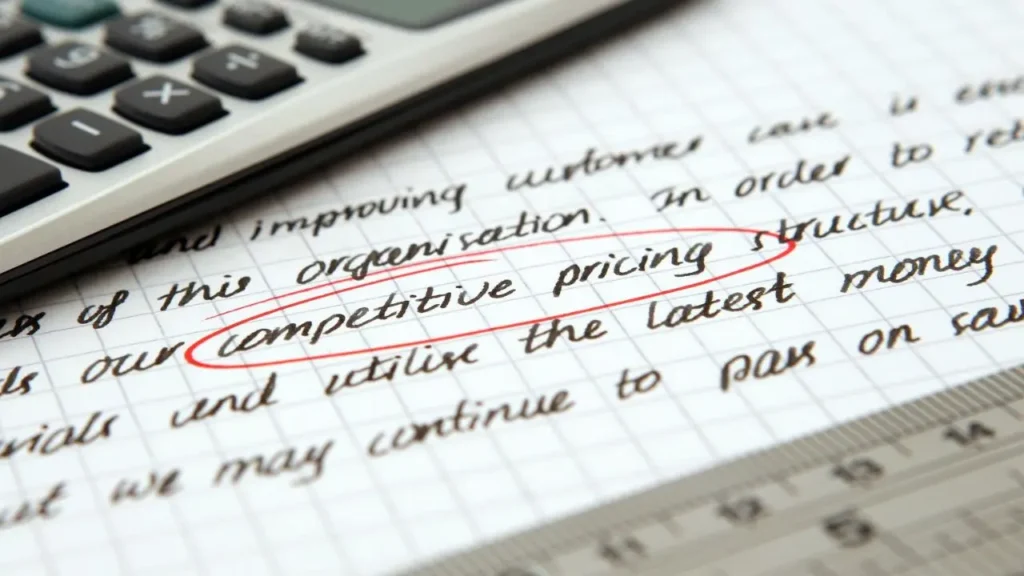
Price competition, also known as competitive pricing, involves setting prices relative to those charged by competitors.
Price competition provides a reference when setting your own prices, particularly when it comes to very similar products or substitutes to be launched on the market to replace items whose prices are well known to consumers.
Introduction
The market is a very important concept for the company, it is defined by the needs it meets, by the customers it targets and by the competitors it competes with.
For this, and to face the competition, the adoption of a pricing policy adapted to its market is one of the most important commercial decisions of the company, for which it must devote a lot of time to setting a competitive price by taking into consideration the prices of the competition which are essential parameters not to be neglected in the price setting process.
I- Definition of competition
Competition is a market structure in which there are enough buyers and sellers that none of them can influence the price. It is therefore an economic situation characterized by rivalry between different firms whose supply is substitutable.
Thus, the equilibrium price imposed on consumers results from the confrontation of supply and demand, in this sense competition has the consequence that price compete with each other, pushing companies to practice attractive prices while offering better quality products, thus promoting innovation and diversity of the offer.
II- What are the 3 types of competition?
Generally, we can distinguish threeforms of competition or competitive structures:
1- Direct competition
Direct competition correponds to iner-product competition, that is, between different products. It mainly concerns companies that offer products of the same nature.
2- Indirect competition
Indirect competition concerns so-called substitute products. Indirect competition can be related to inter-segment competition.
3- Potential competition
Potential competition is a type of competition that does not offer similar or inter-substitutable products, but the products it offers may evolve in the same market. Thus, they can at any time offer acompeting product.
III- The pricing strategy
Pricing strategy is the pricing method a company uses. It corresponds to the set of choices and actions taken by the company to set the selling price level of its products.
This decision is based on many factors:
- The company’s internal costs, including production, labor, marketing, and many other expenses. All of these costs together constitute what is called the cost price;
- The cost “accepted” by customers, i.e. the price they are willing to pay to have this product;
- Product life cycle;
- The price positioning of the competition.
There are several pricing policies that a company can adopt, the most well-known of which are:
- The penetration pricing strategy;
- The skimming pricing strategy;
- The value-based pricing strategy;
- The pricing strategy based on competition;
- The cost-increase pricing strategy.
It should be noted that the pricing strategy is based on three main pillars, namely:
1- Price analysis
One of the main reasons for analyzing competition is to know how competitors set their prices, in order to optimize one’s own prices for the market, in order to have a competitive price capable of giving oneself a competitive advantage over its competitors.
Moreover, competitive pricing analysis (Price competition) is no longer an option, but a necessity, which consists of researching and understanding the strengths and weaknesses of its competitors, then comparing them to those of its own company in order to improve its performance.
2- Price monitoring
Price monitoring and tracking is a process by which a company analyzes a specific market, focusing on the prices of products available for sale.
The information gathered allows the company to determine whether its offerings are attractive to customers compared to those of its competitors. It can then modify its pricing strategy and anticipate competitors’ moves.
This practice offers the company several advantages. It allows it to:
A- Gain valuable information about competitors, which gives you the opportunity to anticipate your competitors’ behavior in the future.
B- Seize opportunities to:
- Identify products that only require a minimal price drop to move to the top of product lists.
- Find out where it can increase its prices while remaining at the top of the product rankings.
C- Always being up to date, through market analysis, it ensures that the products in its offer are always attractive to its customers.
3- Price fixing
The setting of the sale price is based on three logics:
A- Costs
the selling price must cover, in addition to the cost price, a margin of profitability for the company.
B- Demand
The price must be consistent with consumer expectations, which maximizes their demand in terms of price and quality.
C- Competition
Prices are set based on those of the product’s direct competitors. Price competitiveness helps ensure the company’s market share.
However, in the event of a price war, the result of one retaliatory price slashing after another is often a precipitous decline in industry profits.

IV- Price strategy based on competition
Competition based pricing is a pricing strategy in which the company sets the price of its products only after observing the competition and the competitor rate of rivals’ products.
Moreover, as part of a price competition strategy, the process of monitoring and analyzing competitor prices is extremely important, as it allows the company to quickly identify the movements of its competitors and react accordingly.
In addition to the visibility of its products in the market, the most important thing for the company is to ensure that its offerings are at least as good as those of its competitors.
Hence the importance of constant price monitoring and management, to ensure that it is always up to date with information on the prices of products offered by its competitors, in order to react quickly to market changes and develop clear and effective strategies for the future.
It is important to point out that through competitor oriented pricing, the company can place its products at one of the following three price levels:
- Similar prices to those of the competition;
- Higher prices to those of the competition, to position its articles as being of better quality;
- Lower prices than the competition, to create an impact on consumers with high price elasticity, i.e. a small reduction in price generates a significant increase in demand.
However, to succeed the price competition strategy, it is crucial that the company carries out, in addition to an in-depth analysis of the prices charged by the competition, analysis of the marketing strategy of its competitors.
This analysis of price competition will allow the firm to better understand not only its competitors’ prices, but also their offerings, their positioning, and how they attract and retain customers.
This helps it strategically adjust its prices to consistently maintain competitive prices in the market, giving it a competitive advantage over rival companies.
V- Advantages and risks of competition-based pricing
1- Advantages of competition-based pricing
Price competition approach provides several benefits to the company, including:
- Contributes to market balance;
- Involves a low risk of pricing error, by choosing identical orveryclose to those of the competition;
- Allows market share to be maintained;
- Allows you to gain customers on an ad hoc basis;
- Provides more flexibility in combining competition-based pricing with other pricing policies;
- Ensures greater reliability in the value perceived by the consumer in relation to the fixed price.
2- Risks of competition-based pricing
L’adoption of the pricing strategy adapted to competitors is not without risks, such as:
- Price war which leads to a decrease in revenue or even negative margins for the companies involved;
- Growth slowdown due to stagnation of incomes due to similarity of prices;
- Difficulty in standing out for the company that decides to follow the prices of its competitors;
- Technical and financial complications for the small business in collecting and comparing prices which require a lot of time and resources.
The competition-based pricing strategy must be supplemented by other tactics to attract new customers continuously.
Conclusion
In principle, competitive play stimulates innovation, growth and generates substantial gains for the community, because competitors are a form of guarantee against abusive price increases.
However, excessive competition resulting in the application of a low price can become problematic if it is lower than the cost of production and if it has the effect of ousting or preventing access to the market of an equally efficient competitor, by forcing companies to manufacture or supply inferior products to compensate for the loss of profit, which can lead to a massive destruction of value for the entire sector.

cgw97l
**mindvault**
mindvault is a premium cognitive support formula created for adults 45+. It’s thoughtfully designed to help maintain clear thinking
**glpro**
glpro is a natural dietary supplement designed to promote balanced blood sugar levels and curb sugar cravings.
**sugarmute**
sugarmute is a science-guided nutritional supplement created to help maintain balanced blood sugar while supporting steady energy and mental clarity.
**vitta burn**
vitta burn is a liquid dietary supplement formulated to support healthy weight reduction by increasing metabolic rate, reducing hunger, and promoting fat loss.
**synaptigen**
synaptigen is a next-generation brain support supplement that blends natural nootropics, adaptogens
**glucore**
glucore is a nutritional supplement that is given to patients daily to assist in maintaining healthy blood sugar and metabolic rates.
**prodentim**
prodentim an advanced probiotic formulation designed to support exceptional oral hygiene while fortifying teeth and gums.
**nitric boost**
nitric boost is a dietary formula crafted to enhance vitality and promote overall well-being.
**sleep lean**
sleeplean is a US-trusted, naturally focused nighttime support formula that helps your body burn fat while you rest.
**wildgut**
wildgutis a precision-crafted nutritional blend designed to nurture your dog’s digestive tract.
**mitolyn**
mitolyn a nature-inspired supplement crafted to elevate metabolic activity and support sustainable weight management.
**zencortex**
zencortex contains only the natural ingredients that are effective in supporting incredible hearing naturally.
**yusleep**
yusleep is a gentle, nano-enhanced nightly blend designed to help you drift off quickly, stay asleep longer, and wake feeling clear.
**breathe**
breathe is a plant-powered tincture crafted to promote lung performance and enhance your breathing quality.
**prostadine**
prostadine is a next-generation prostate support formula designed to help maintain, restore, and enhance optimal male prostate performance.
**pineal xt**
pinealxt is a revolutionary supplement that promotes proper pineal gland function and energy levels to support healthy body function.
**energeia**
energeia is the first and only recipe that targets the root cause of stubborn belly fat and Deadly visceral fat.
**prostabliss**
prostabliss is a carefully developed dietary formula aimed at nurturing prostate vitality and improving urinary comfort.
**boostaro**
boostaro is a specially crafted dietary supplement for men who want to elevate their overall health and vitality.
**potent stream**
potent stream is engineered to promote prostate well-being by counteracting the residue that can build up from hard-water minerals within the urinary tract.
**hepatoburn**
hepatoburn is a premium nutritional formula designed to enhance liver function, boost metabolism, and support natural fat breakdown.
**hepato burn**
hepato burn is a potent, plant-based formula created to promote optimal liver performance and naturally stimulate fat-burning mechanisms.
**flow force max**
flow force max delivers a forward-thinking, plant-focused way to support prostate health—while also helping maintain everyday energy, libido, and overall vitality.
**neurogenica**
neurogenica is a dietary supplement formulated to support nerve health and ease discomfort associated with neuropathy.
**cellufend**
cellufend is a natural supplement developed to support balanced blood sugar levels through a blend of botanical extracts and essential nutrients.
**prodentim**
prodentim is a forward-thinking oral wellness blend crafted to nurture and maintain a balanced mouth microbiome.
**revitag**
revitag is a daily skin-support formula created to promote a healthy complexion and visibly diminish the appearance of skin tags.
Thanks for sharing. I read many of your blog posts, cool, your blog is very good.
Can you be more specific about the content of your article? After reading it, I still have some doubts. Hope you can help me.
ok
Thank you for your sharing. I am worried that I lack creative ideas. It is your article that makes me full of hope. Thank you. But, I have a question, can you help me? https://accounts.binance.com/id/register-person?ref=UM6SMJM3
Thank you
welcome